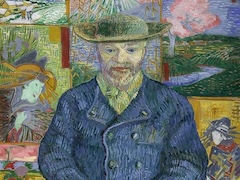Early Life and Education
Vincent Willem van Gogh was born on March 30, 1853, in Zundert, Netherlands, to Theodorus van Gogh, a Protestant minister, and Anna Cornelia Carbentus. He was the eldest of six children. Van Gogh's early life was marked by a deep interest in art and literature, though he did not initially pursue a career in the arts. At 16, he began working for the art dealers Goupil & Cie in The Hague, which exposed him to a wide range of artworks and artists. This experience, however, did not lead to a lasting career in art dealing.
Artistic Development
Early Works
In 1880, van Gogh decided to become an artist. His early works, created in the Netherlands, depicted rural life and were characterized by dark, earthy tones. "The Potato Eaters" (1885) is a notable example from this period, showcasing his focus on peasant life and social realism.
Paris Period
In 1886, van Gogh moved to Paris to live with his brother Theo, an art dealer. During his two-year stay, he encountered Impressionist and Post-Impressionist artists, including Claude Monet and Paul Gauguin. This exposure led him to adopt brighter colors and experiment with new techniques, moving away from his earlier somber palette.
Arles and the South of France
Seeking a change, van Gogh relocated to Arles in 1888. Inspired by the vibrant light and colors of the region, he produced some of his most famous works, such as "Sunflowers" and "The Bedroom." He invited Paul Gauguin to join him, hoping to establish an artists' community. Their collaboration was short-lived and ended after a heated argument, during which van Gogh famously mutilated his own ear.
Mental Health and Later Years
Van Gogh's mental health deteriorated over time. After the incident with Gauguin, he admitted himself to the Saint-Paul-de-Mausole asylum in Saint-Rémy-de-Provence in 1889. Despite his struggles, he continued to paint, producing works like "The Starry Night." In May 1890, he moved to Auvers-sur-Oise under the care of Dr. Paul Gachet. On July 27, 1890, van Gogh sustained a gunshot wound, believed to be self-inflicted, and died two days later at the age of 37.
Artistic Style and Influences
Van Gogh's style is marked by bold colors, dynamic brushwork, and emotional intensity. He was influenced by Dutch masters like Rembrandt, French Realists such as Jean-François Millet, and Japanese ukiyo-e prints, which he collected and admired. His work laid the foundation for Expressionism and had a profound impact on 20th-century art movements.
Legacy
Although van Gogh sold only one painting during his lifetime, his work gained immense recognition posthumously. Today, he is celebrated as a pioneer of modern art, with his paintings housed in major museums worldwide. The Van Gogh Museum in Amsterdam holds the largest collection of his works, attracting millions of visitors annually.
Notable Works
- –
The Potato Eaters (1885): A depiction of a peasant family at mealtime, reflecting van Gogh's early focus on rural life.
- –
Sunflowers (1888): A series of paintings featuring vibrant sunflowers in various stages of life, symbolizing gratitude and admiration.
- –
The Bedroom (1888): An intimate portrayal of van Gogh's bedroom in Arles, emphasizing simplicity and comfort.
- –
The Starry Night (1889): A swirling night sky over a quiet village, representing van Gogh's emotional turmoil and fascination with the cosmos.
- –
Self-Portrait with Bandaged Ear (1889): A self-portrait painted after the incident with Gauguin, showcasing van Gogh's resilience and introspection.
Correspondence
Van Gogh's letters, particularly those to his brother Theo, provide deep insight into his thoughts, struggles, and artistic process. These letters are considered valuable documents in understanding his life and work.
Exhibitions and Cultural Impact
Van Gogh's works have been the subject of numerous exhibitions worldwide. In 2024, the National Gallery in London hosted "Van Gogh: Poets and Lovers," focusing on his time in Provence and his connection to poetry and emotion. His life and art continue to inspire films, literature, and popular culture, cementing his status as a central figure in art history.
